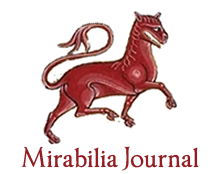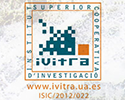Absolute vision and vision of the Absolute in Nicholas of Cusa
Claudia D’AMICO
Original title: Visión absoluta y visión de lo absoluto en Nicolás de Cusa
Published in Mystic and Millenarianism in Middle Ages
Keywords: Absolute vision, Middle Ages, Mystical vision, Neoplatonism, Nicholas of Cusa.
Introducing the topic of the mystical vision, Nicholas of Cusa becomes the heir of the Neoplatonic tradition while he supposes as the foundation of such a view the same absolute vision. However, his thought is characterized by a parallelism between absolute and human vision to the point that the man can make himself visible the vision of God only by means of selfcontemplation of the dynamism of his own vision.
Figure and meaning of Venus in the artwork of Botticelli
Laura CASADO BALLESTEROS
Original title: Figura y significado de Venus en la obra de Botticelli
Published in
Keywords: Botticelli, Mythology, Médici, Neoplatonism, Renaissance, Venus, Virgin.
The representation of Venus in Botticelli’s painting has always been present, not only to reflect the goddess as another image, but as a representation in which the painter goes beyond the mythological theme that the goddess occupies, reflecting a whole series of elements that are part of the world of the symbol. As well as the importance of the philosophical lessons of Neoplatonic character in the subject that occupies to us, that already were object of debate in this epoch and will be us of great utility to establish a correct and coherent interpretation of the hidden message of these mythological works.
Philosophy as a Way of Life in the Platonism of Imperial Age and in Plotinus
Bernardo Lins BRANDÃO
Original title: A Filosofia Como Modo de Vida no Platonismo da Era Imperial e em Plotino
Published in Mulier aut Femina. Idealism or reality of women in the Middle Ages
Keywords: Ascension, Neoplatonism, Philosophy as a way of life, Plotinus, Therapy of passions.
Philosophy is generally understood nowadays as a discursive practice, in which philosophers elaborate doctrines and arguments. But that is not the only possible view. In some contexts of Antiquity, it was also conceived as a way of life. In this paper, I analyze how the platonism of the Imperial age, specially Plotinus, saw this philosophical life and how doctrine and argument, ascension of the soul and therapy of passions was part of it.
The School of Alexandria and the use of allegorical method by Origen of Alexandria
Eirini ARTEMI
Published in
Keywords: Allegory, Celsus, Neoplatonism, Origen, Platonism, School of Alexandria.
In this paper it will be examined the School of Alexandria. The latter was a great center of Christianity, for a span of five centuries, until the reign of Justinian (529 A.D.). In it, the first system of Christian theology was formed and the allegorical method of biblical exegesis was devised. The School of Alexandria adopted the allegorical interpretation of the Holy Scripture, believing that it hides the truth and at the same time reveals it. It hides the truth from the ignorant, whose eyes are blinded by sin and pride, hence they are prevented from the knowledge of the truth. Origen, one of the greatest Christian theologians employed the allegorical method of the interpretation of the Bible in the belief that he was explaining them, whereas he was exploiting them on behalf his own dogmatic teaching. He was accused of that by other fathers of the Christian Church but also by many heretics. Origen had to defend his exegetical method against the various attacks from heretics, from laymen the church and from Celsus who attacked the Christian writers because, being «ashamed of these things (which are written the Bible), they take refuge allegory». On the other hand, Origen was not a «pure» allegorist in that he has some place for literal interpretation as well. Finally, Origen’s basic commitments were to the Scriptures as the word of God, the church as the guardian of the tradition and the household of faith, and to Platonic metaphysics He thus wanted to hold both to his literally true Christian history, and to his spiritually true Platonism and Neoplatonism.
The degrees of knowledge to the mystical vision in the thought of Nicholas of Cusa (1401-1464)
José GONZÁLES RÍOS
Original title: Los grados de conocimiento hacia la visión mística en el pensamiento de Nicolás de Cusa (1401-1464)
Published in Mystic and Millenarianism in Middle Ages
Keywords: Knowledge, Metaphysics, Mystical vision, Neoplatonism, Nicholas of Cusa.
The speculation on the topic of vision (visio), and in it around the mystical vision (visio mystica), is rich in the system of thought of Nicholas of Cusa. It is permanently present in his sermons, letters and in the rest of his theological and philosophical work. While there are various ways to address it, we propose considering it from his metaphysics of the human mind (mens human) point of view, and in it through the consideration of the degree of knowledge what the mind gradually transit in the conjectural searching of vision of the first principle from which she and all proceeds. To this end, we will address the topic of the mystical vision by considering first, the elements that Cusano gives in the context of his early sermons (before 1440). Second, through the presentation of the degrees of knowledge of the human mind, as they appear in the first great metaphysical systematization of knowledge in the books of De coniecturis (1442/3).Third, we discuss the topic in his work De visione Dei (1453). Analyzing this elements we hope to show that the topic of the mystical vision in the thought of Nicholas of Cusa is inseparable from his metaphysics of the human mind.
The discussion on the origin of evil in Pseudo-Dionysius Areopagite’s De divini nominibus and its dependence on Proclus’ De malorum subsistentia
Matteo RASCHIETTI
Original title: A discussão sobre a origem do mal no De divini nominibus do Pseudo-Dionísio Areopagita e sua dependência do De malorum subsistentia de Proclo
Published in Games from Antiquity to Baroque
Keywords: Neoplatonism, Origin of Evil, Parhypostasis, Proclus, Pseudo-Dionysius Areopagite.
There are strong similarities between chapter IV of Pseudo-Dionysius Areopagita’s De divini nominibus and Proclus’ De malorum subsistentia, as pointed out by the research of Hugo Koch and Joseph Stiglmayr at the end of the 19th century, revealing a dependence of the former on the latter. The purpose of this article is to analyze this relationship of dependence and its consequences in the history of the interpretation of pseudodionysian works.
The play of divine beauty: Bronzino’s decoration of the Chapel of Eleonora in the Palazzo Vecchio (1541-1543)
Thainan Noronha de ANDRADE
Published in Games from Antiquity to Baroque
Keywords: Agnolo Bronzino, Chapel of Eleonora, Neoplatonism.
Starting in 1540, Cosimo I de' Medici (1519-1574) commissioned a series of structural and decorative reforms in the old seat of the Republic of Florence, the Palazzo della Signoria, transforming it into the official residence of his principato. One of the first artistic commissions ordered by the duke was the chapel dedicated to his wife, Eleonora de Toledo (1522-1562), decorated in fresco by Agnolo Bronzino (1503-1572) between 1541 and 1543. This chapel stands out as one of the earliest and most significant examples of the Florentine aesthetic language from the mid-16th century. Resulted from a series of artistic and theoretical developments that took place in the first half of the century, it is characterized by highly symbolic expressiveness whose content manifests in a polysemic manner, simultaneously incorporating various levels of meaning, including political, religious, and philosophical elements. In this sense, the present study analyzes the respective pictorial cycle considering the Neoplatonic aesthetic speculations circulating within Italian and Florentine culture, influencing contemporary conceptions of the nature of artistic beauty and its appreciation, linking this process to a broader attitude that characterized Medici patronage.
Time and Eternity in Saint Augustine
Marcos Roberto Nunes COSTA
Original title: Tempo e Eternidade em Santo Agostinho
Published in The Time and the Eternity in the Ancient and Medieval World
Keywords: Eternity, Manichaeism, Neoplatonism, Saint Augustine, Time.
Every Augustinian disputation regarding to time - eternity relation arises from the need of combating the Manicheans and, by indirection, all those ones that affirmed, asserted world eternity, that denied ex nihilo Jewish - Christian Creation principle. Saint Augustine, departing from Genesis Scriptural Book in order to present a revelational founding and neoplatonic philosophy, in order to impart philosophic maintenance to the above - mentioned thesis, has ended up by moving away from not only Manichaeism, but from Neo-Platonism itself which has worked as philosophical foundation for contesting those ones.






















































































